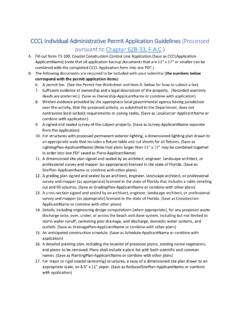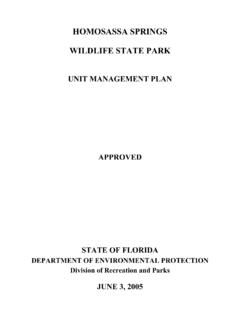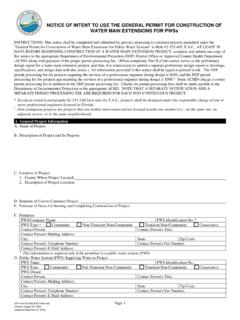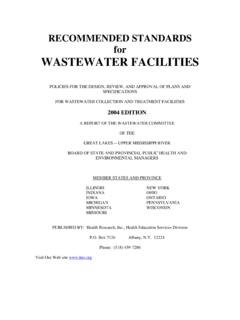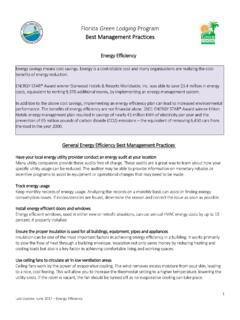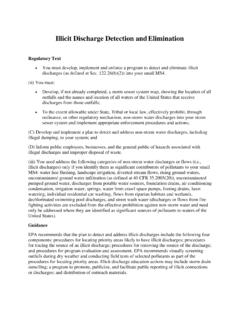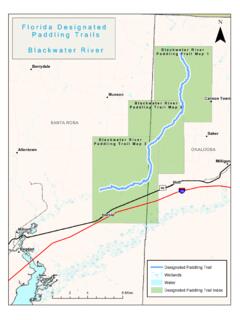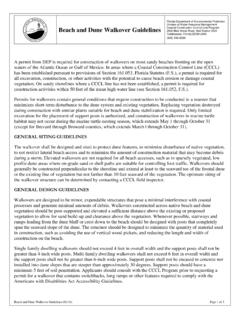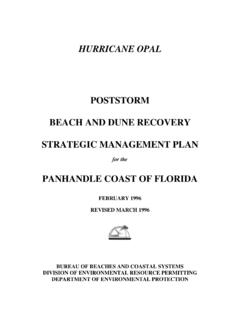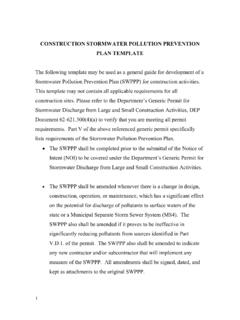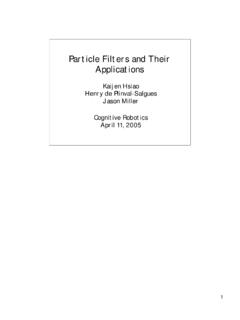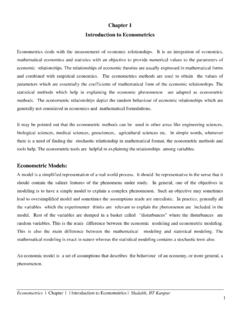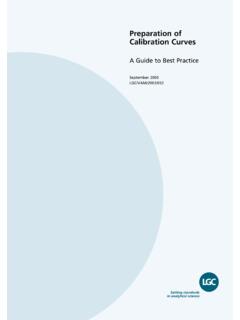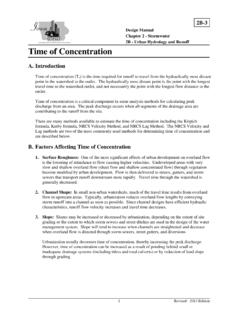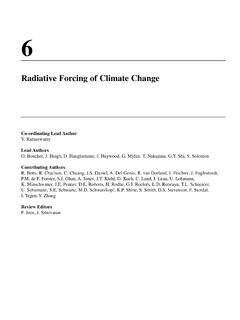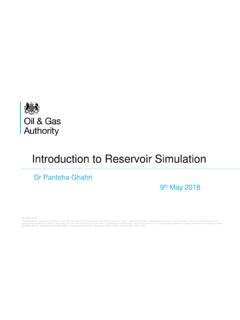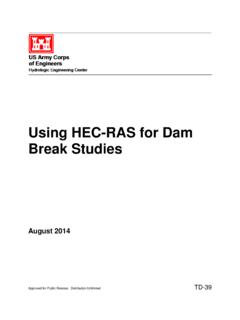Transcription of Calculation on Un-ionized NH3 in Fresh
1 Page 1 of 16. Revision 2. Date 02/12/2001. FINAL. FLORIDA DEPARTMENT OF ENVIRONMENTAL PROTECTION. CHEMISTRY LABORATORY methods MANUAL, TALLAHASSEE. Calculation OF Un-ionized AMMONIA IN Fresh WATER. STORET Parameter Code 00619. Background The Calculation technique presented here is for estimating the concentration of Un-ionized ammonia in Fresh water based on the data and information provided by Thurston, et. al. (Reference 1). Although the method was developed for solutions of zero salinity, it is applicable to dilute saline solutions without serious error (see note, below). Summary of Method In aqueous solution, unionized ammonia exists in equilibrium with ammonium ion and hydroxide ion.
2 The equilibrium constant for this reaction is a function of temperature and solution pH. Thus, if the equilibrium constant is known for a particular temperature and the pH of the solution is also known, the fraction of un- ionized ammonia can be calculated. Then, if the total ammonium concentration is known from laboratory analysis, the Un-ionized ammonia concentration can be calculated. It must be noted however that the concentration of Un-ionized ammonia is also dependent on the ionic strength of the solution. There is a slight decrease in the Un-ionized ammonia fraction of total ammonia as the ionic strength of the solution increases.
3 A method to estimate Un-ionized ammonia in saline waters is provided in Appendix III. WARNING: Before using these procedures to determine Un-ionized Ammonia, one must study the equations in the following sections to obtain an understanding of the influence of the several measured parameters - Total Ammonium, mg/L; Temperature, oC; pH, units; and Salinity, ppt (if salinity corrections are appropriate) - on the resultant Un-ionized Ammonia value. While a detailed analysis will not be presented here, the errors which may be tolerated for these parameters in order to report Un-ionized Ammonia to two significant figures are given in the table below: _____.
4 Note: For saline (marine or brackish) water with salinity (in parts per thousand, o/oo) of 5 o/oo to 35 o/oo and temperature from 5oC to 35oC and pH from to ; see Appendix III. CAUTION: Un-ionized Ammonia data obtained using the salinity correction calculations of Appendix III are not approved for STORET entry under STORET Code 00619. Page 2 of 16. Revision 2. Date 02/12/2001. Parameter Error Total Ammonia (mg/L) +/- 5%. Field Temperature (oC) +/- oC. Field pH (units) +/- unit Salinity (ppt) +/- 1 ppt NOTE: these are total measurement errors including precision and accuracy. Except for field pH, the usual measurement methods for these parameters commonly yield equal or smaller uncertainties than those stated above.
5 Extreme care should be exercised in the measurement of pH to be within +/- unit of the true value. Salinity may be measured in the field or in the laboratory, following the prescribed methods and sample handling in the DEP regulations (see Chapter 62-160 FAC). Definition of Terms Used in Calculations 1. Overall chemical equilibrium involved: K1 K2. NH3 (g) + nHOH = (aq.) = NH4+ + OH- + (n-1)HOH (l). The equilibrium associated with K1, can be considered to be negligible in its effect on subsequent calculations only if the sample is collected correctly and if field temperature and field pH measurements are made promptly.
6 Temperature and pH values other than field measurements cannot be used. 2. Chemical equilibrium used in calculations: K2. (aq.) = NH4+ + OH- + (n-1)HOH. Although the dissolved ammonia molecule exists in hydrated form and is associated with at least three water molecules (Reference 2), the equation can be simplified: K2. = NH4+ + OH- and the equilibrium constant K2 = [NH4+][OH-]/[ ] where K2 = Kb = equilibrium constant (base form). [NH4+] = concentration of ammonium ion, mole/L. [ ] = concentration of Un-ionized ammonia, mole/L. [OH-] = concentration of hydroxide ion, mole/L. [H+]= concentration of hydronium ion, mole/L.
7 Page 3 of 16. Revision 2. Date 02/12/2001. 3. Other Terms Used: Kw = [H+][OH-] equilibrium constant for water Kw = Ka Kb acid/base/water equilibrium constant relation pH = -log [H+] definition pKa = -log Ka definition pKb = -log Kb definition 4. Equilibrium Constant - Temperature Relation The key to this entire Calculation technique was the establishment of a satisfactory empirical mathematical expression relating the equilibrium constant and the temperature. Within the temperature range of 0oC-50oC. and a pH range of to , this expression is: pKa = + where Tk is temperature in degrees Kelvin, Tk = oC + 5.
8 Un-ionized Ammonia The fraction of Un-ionized ammonia is given by the following expression (see Appendix I): (pKa-pH). f = 1/(10 + 1). 6. Calculations f = [ ]/([NH4+] + [ ]). = ( Un-ionized ammonia, mole/L)/(total ammonia, mole/L). where f is actually the mole fraction of Un-ionized ammonia. Concentration units other than mole/L can be used to describe both Un-ionized ammonia and total ammonia. However, the units must be identical for each in these calculations for the constant f to remain numerically correct. The usual laboratory results for ammonia analysis are for total ammonia-nitrogen and are expressed in terms of total ammonia-nitrogen, (NH3 - N)t, mg/L.
9 Page 4 of 16. Revision 2. Date 02/12/2001. where: (NH3 - N)t = ( - N) + (NH4+ - N). (total ammonia - nitrogen, mg/l)t =(unionized ammonia - nitrogen, mg/l) + (ammonium ion-nitrogen,mg/l). The fraction of Un-ionized ammonia can be expressed as: f = (( - N), mg/L)/((NH3 - N)t, mg/L). Note that the concentration units for both numerator and denominator are identical. Thus, if the fraction of Un-ionized ammonia is known for a particular temperature and pH and the laboratory analytical results for total ammonia-nitrogen, mg/L, is known, the Un-ionized ammonia-nitrogen, mg/L, can be calculated.
10 However, it is desired that concentration of Un-ionized ammonia be expressed in terms of mg/L ammonia, not mg/L ammonia-nitrogen. A conversion will be necessary using the appropriate formula weights: ( - N) mg/L x (17/14) = (NH3) mg/L. ( Un-ionized ammonia, as mg/L nitrogen)(17/14) = ( Un-ionized ammonia as mg/L NH3). 7. Example The following field and laboratory data were obtained for a Fresh water sample collected in the vicinity of Palatka. Field temperature, T = Field pH, pH = Total ammonia-nitrogen, (NH3 - N)t = mg/L. From APPENDIX II (Reference 1), the percent Un-ionized ammonia at pH = and T = is Therefore, the fraction of Un-ionized ammonia is f = The concentration of Un-ionized ammonia is: (NH3 - N)t (.)
